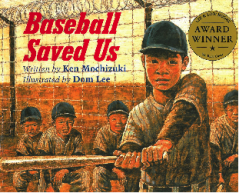![]() Jaclyn DeForge, our Resident Literacy Expert, began her career teaching first and second grade in the South Bronx, and went on to become a literacy coach and earn her Masters of Science in Teaching. In her column she offers teaching and literacy tips for educators.
Jaclyn DeForge, our Resident Literacy Expert, began her career teaching first and second grade in the South Bronx, and went on to become a literacy coach and earn her Masters of Science in Teaching. In her column she offers teaching and literacy tips for educators.
Over the past several weeks, I’ve been modeling how to do a close reading at several different grade levels. Next up: Close Reading in Third Grade using the O level text Baseball Saved Us by Ken Mochizuki and illustrated by Dom Lee.
One way to structure close reading questioning is to use the format laid out by the Institute for Learning of the University of Pittsburgh. Under their framework, students read the text selection four times: first, to get the gist; second, to find significant moments or ideas; third, to interpret the ideas in the text; and finally, to analyze the author’s methods (craft). Here’s an example of how to plan out your questions for close reading of just the first 8 pages of Baseball Saved Us:
1st reading (read to get the gist):
- Which characters have we met so far in the story? What do we know about each character so far? Cite evidence from the text to support your answers.
- Where does the story take place? In what country? During what period in history? How do you know? Cite evidence from the text to support your answers.
- How did the characters get to the camp? Why are they there? What is the purpose of the camp? What hardships did the main character’s family face at the camp? How is life at the camp similar to or different from life at home? How does life at the camp affect the people in the story? How do you know? Cite evidence from the text to support your answers.
- Summarize what you have learned about the narrator. How does he see himself? How do others view him? How do you know? Cite evidence from the text to support your answers.
2nd reading (read to find significant moments or ideas):
- What is the most important thing you learned or that happened in this section of the story? Why is it significant? Cite evidence from the text to support your answers.
3rd reading (read to interpret ideas):
- The characters in Baseball Saved Us were Japanese Americans who lived on the West Coast at a time when the United States was fighting a war with Japan. Do you think it was fair for the government to take them from their homes and make them move into an internment camp? Why do you think the government made this decision? Do you agree with the decision? What does it mean to be an American? Do you think the author would agree with you? Do you think the character of Dad would agree with you? Why or why not? Cite evidence from the text to support your answers.
4th reading (read to analyze the author’s methods/craft):
- Based on what you have read so far, how do you think author Ken Mochizuki feels about Japanese internment during World War II? How does he want you to feel about internment camps, specifically about the camp in the story? How do you know? What details does he choose to include in order to influence the reader? Cite evidence from the text to support your answers.
- What is the mood of the story so far? How does illustrator Dom Lee create this mood in his illustrations? Cite evidence from the text to support your answers.
By asking students to ground their responses in the text by citing text-based support for their answers, the following Common Core Standard is addressed:
Reading Literature, Grade 3, Key Ideas and Details, Strand 1: Ask and answer questions to demonstrate understanding of a text, referring explicitly to the text as the basis for the answers.
How does close reading look in your classroom? Any tricks and tips to share?
Further reading:
- What is close reading?
- What does close reading look like in Kindergarten?
- What does close reading look like in First Grade?
- What does close reading look like in Second Grade?
Filed under: Curriculum Corner, Resources Tagged: Baseball Saved Us, close reading, common core standards, Dom Lee, Educators, guided reading, Ken Mochizuki, Reading Aloud, reading comprehension, slow reading





[...] What does close reading look like in third grade? [...]
[...] What does close reading look like in third grade? [...]
[...] What does close reading look like in Third Grade? « the open book on December 3, 2012 at 7:03 [...]
[...] What does close reading look like in Third Grade? [...]